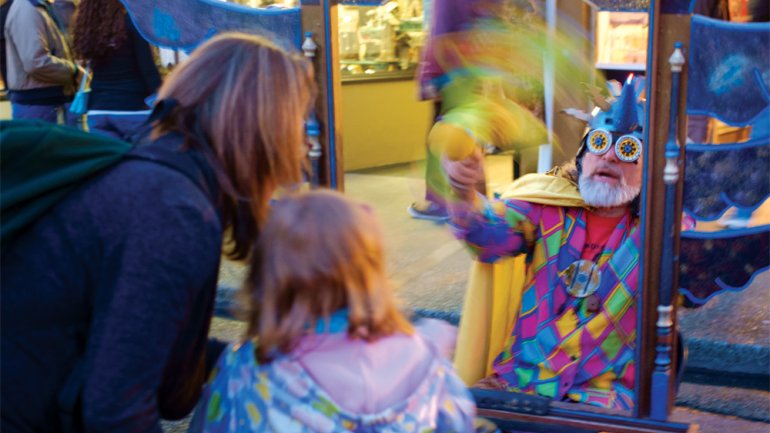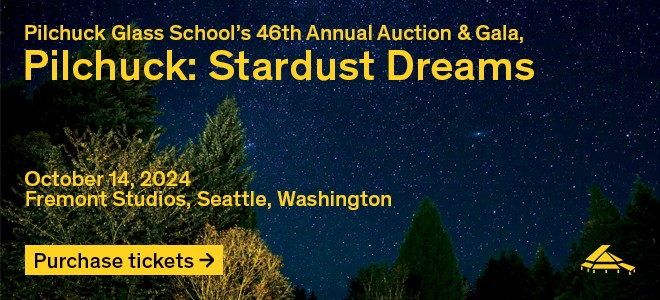Bohemian Rhapsody: Olympia, Washington
Bohemian Rhapsody: Olympia, Washington
This small city at the tip of Puget Sound can claim more craft per square mile than many larger locales.
Lying midway between two craftopias – Portland, Oregon, and Seattle – Olympia, Washington, might seem like pretty small potatoes. It’s got an indie-alt- treehugger charm, and, as the state capital, it’s probably a fun place for political junkies. But with a population that barely scrapes 50,000, it’s simply not big enough to support much of a craft scene. Right?
Wrong. Olympia punches above its weight, supporting vibrant galleries and craft fairs. A longstanding community of notable makers such as Nikki McClure and Jay T. Scott call it home, thanks to its relaxed pace and gorgeous setting. It’s a place where environmentalism and sustainability are watchwords, where old-growth hippies rub elbows with pierced punks, where numerous coffee and craft-beer purveyors share sidewalks with numerous tattoo parlors. And it’s where studio craft artists work side by side with DIY makers.
“Olympia has always been a town that’s very welcoming to alternative communities,” says Susan Warner, a former Olympian, now artistic director at the Museum of Glass in Tacoma about 30 miles north. “It also doesn’t hurt that there are three colleges here,” adds artist Gail Tremblay, who just retired from the Evergreen State College. (The others are South Puget Sound Community College and St. Martin’s University.) Evergreen is particularly known for its nonconformist philosophy (case in point: the school mascot is a large mollusk), and it draws students with a similar bent from all over the country.
Once here, many of them put down roots. Compared to Seattle or Portland, “it’s much easier to start a studio and afford to stay and do work here,” says Tremblay, “but you can show in either place.”
Downtown
The farmers’ market, on the north edge of downtown, is a good way to get a taste of Olympia, literally and figuratively. Open year-round, it kicks into high gear from spring through fall, with produce, much of it organic, and a dizzying assortment of artisan-made edibles (no artisanal Jell-O – thus far). Also selling there are 20-some object-oriented artisans working in a range of mediums. Just south of the market, the artists’ co-op Splash Gallery offers more local craft.
A few blocks southeast is AntiMatter Gallery, rising from the ashes of its predecessor, the artist-owned Matter gallery. Priced out of their original spot downtown in 2015, three of the co-owners have regrouped in a smaller space, retaining Matter’s focus on local and regional artists using found and recycled materials. The new gallery is in an industrial area, so the owners hope to capitalize on foot traffic from the neighboring weekend antiques and flea market, as well as Furniture Works, a store focusing on midcentury modern and locally made furniture.
A few blocks south, the Arbutus Folk School offers a more hands-on experience. Stacey Waterman-Hoey, a former policy wonk, founded the school with woodworker Matt Newton in 2013. The nonprofit space has a woodshop, ceramic studio, and small gallery and store. Other recent offerings include embroidery, pattern-making, metal arts, and music classes.
Heading west, within a four-block area, is a mix of other venues that exemplifies the area’s eclectic tastes. Obsidian transforms from a coffeehouse and restaurant by day to a punk/goth-centric bar at night, and hosts a Makers’ Market as well as the Stitch n’ Witch knitting circle; Mansion Glass, which since 1973 has created stained-glass installations for churches, restaurants, banks, and casinos; State of the Arts Gallery, showing regional craftspeople; and Compass Rose, a high-end boutique that features local jewelry designers and letterpress artists.
Childhood’s End Gallery at the western edge of downtown can claim near-institutional status. Established in 1971, the expansive space exhibits work by national, regional, and local artists such Chris Maynard, who creates intricate shadow boxes of carved feathers, Earle McNeil, a retired sociology professor who makes kaleidoscopes, and jewelry designer Paul Wagner.
From there, it’s a quick walk north to Percival Landing, home to a series of plinths that showcase a changing array of work by regional artists such as Willow Wicklund, Don Freas, and Colleen Cotey. In true communitarian spirit, citizens can vote for their favorite sculpture each year; the city buys the winner and puts it on permanent display.
Special events
Downtown is also home to several seasonal art events, including Duck the Malls, an annual market of about 50 local artists and artisans that helps raise money for the Olympia Film Society. Then there is the twice-yearly Arts Walk, when businesses of all kinds become de facto galleries, showcasing area artists.
In the spring, the Arts Walk is accompanied by the Procession of the Species – another beast entirely. Started in 1995, the exuberant grassroots celebration features handmade costumes, banners, giant puppets, and floats, created at free community art workshops.
Beyond downtown
West and south of downtown lies South Puget Sound Community College, whose Minnaert Center for the Arts mounts adventurous exhibitions including the textile installations of Amanda McCavour and ceramic work by Aisha Harrison. Before arriving, you can stop at Olympia Coffee Roasting Co.’s new location on Capitol Boulevard, designed by Roussa Cassel with furniture by Michael Hedges (both local) and other artisan elements by buzzy makers Garza Marfa of Texas.
Further west lies the woodsy Evergreen State College campus, a kind of wellspring for artistic activity: Tremblay notes that many of her students, as well as those of other arts faculty such as Jean Mandeberg and Robert Leverich, have remained in the area, creating a second, and sometimes third, generation of artists.
The college’s Longhouse Education and Cultural Center, with a specific focus on the arts and culture of indigenous peoples, also has played a pivotal role. Established in 1996 in partnership with six local Native American tribes, the center has expanded its reach to Native peoples nationwide, and hosts exhibitions, Native art sales, and a residency program.
It’s also expanding physically, with plans for more than 7 acres of facilities for an indigenous arts degree program. A carving studio opened in 2012, and a weaving studio is scheduled for completion in spring 2017. A cast-glass studio – a partnership with the Museum of Glass – is in the works, too, as a complement to the museum’s hot shop.
The Evergreen program will add to an already active community of makers in the regional Native community, such as weavers Patti Puhn of the Squaxin Island tribe, Jack-lyn Smith and Kris Miller (Skokomish), Rodney and Colleen Cawston (Colville), and Chehalis members Yvonne Peterson (also on the Evergreen faculty) and her sister Trudy Marcellay, the third generation of a family of weavers.
Beyond the city limits
As artists spread out from the hub of Olympia, the area has seen a form of artistic diaspora; Artrails of Southwest Washington, held in mid- to late September, offers a look into the studios of the many artists working south of the city.
And in the modest suburb of Lacey, the upscale senior community of Panorama can claim two Dale Chihuly works on the grounds, thanks to centenarian resident and Chihuly mentor Russell Day; the Seventeen51 Restaurant & Bistro, part of the complex, has recently renovated its space, with a hearth crowned by Chihuly works.
More Chihuly is on view a quick half-hour drive north on Interstate 5 at the Museum of Glass, including the spectacular Chihuly Bridge of Glass, as well as work by luminaries such as Harvey Littleton, Toots Zynsky, Joyce J. Scott, and Preston Singletary.
The museum’s hot shop is available not only to glassmakers but also to artists working in other mediums; recently Skokomish and Chehalis weavers reinterpreted traditional basket forms in glass.
In an area where sustainability is a big deal, it’s this kind of continual evolution that sustains art – and the artistic species who makes it, too.
Judy Arginteanu is a writer and American Craft’s copy editor.




